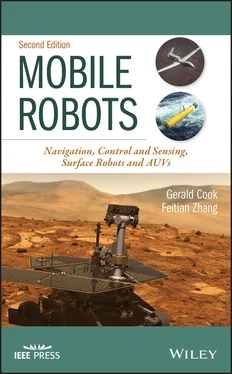In Figure 1.1, we have a diagram for a four‐wheel front‐wheel‐steered robot. The equations would also apply for the case of a single front wheel. The angle the front wheels make with respect to the longitudinal axis of the robot, y robot, is defined as α , measured in the counter‐clockwise direction. The angle that the longitudinal axis, y robot, makes with respect to the y groundaxis is defined as ψ , also measured in the counter‐clockwise direction. The instantaneous center about which the robot is turning is the point of intersection of the two lines passing through the wheel axes.
From geometry we have

which may be solved to yield the instantaneous radius of curvature for the path of the midpoint of the rear axle of the robot.

Figure 1.1 Schematic diagram of the front‐wheel steered robot.
(1.1) 
From geometry we also have

or

which can be written as
(1.2) 
If one held the steering angle α constant, the trajectory would result in a circle whose radius is dictated by the robot length and the actual steering angle used per equation (1.1).
Now the instantaneous curvature itself is defined as the ratio of change in angle divided by change in distance or change in angle per distance traveled. It is given by

which is the inverse of the instantaneous radius of curvature. Thus, the radius of curvature may be interpreted as

i.e., the change in distance traveled per radian change in heading angle.
The complete set of kinematic equations for the motion in robot coordinates are
(1.3a) 
(1.3b) 
(1.3c) 
Converted to earth coordinates these become
(1.4a) 
(1.4b) 
(1.4c) 
This form of the equations is quite simple; however, it should be noted that these equations are nonlinear. Also see Dudek and Jenkin.
Now if we wish to take into account the fact that steering angle and velocity cannot change instantaneously, we may define the derivatives or rates of these variables as control signals, i.e.,
(1.5a) 
and
(1.5b) 
The system of equations for this model is now fifth order. The equations provide the correct kinematic relationships among the variables for motion and rotation in the xy plane but do not include the complexity of suspension or motor dynamics. Also not included in this model are robot pitch and roll.
It may be desirable to form a discrete‐time model from these equations. This would be useful for discrete‐time simulation as well as other applications. Clearly these equations are nonlinear. Therefore, the methods used for converting a linear continuous‐time system to a discrete‐time representation are not applicable. One approach is to use the Euler integration method. This method is a first‐order, Taylor‐series approximation to integration and says that the derivative may be approximated by a finite difference

This can be re‐arranged to yield

Setting t = kT and the sampling interval Δ t = T and applying this to the above equations we have
(1.6a) 
(1.6b) 
(1.6c) 
(1.6d) 
and
(1.6e) 
Here the sampling interval T must be chosen to be sufficiently small depending on the dynamics of the original differential equations, i.e., the behavior of the discrete‐time model must match up with that of the original system. For a linear system, this corresponds to selecting the sampling interval to be approximately one‐fifth of the smallest time constant of the system or smaller depending on the degree of precision required. For nonlinear systems, it may be necessary to determine this limiting size empirically. This discrete‐time model may be used for analysis, control design, estimator design, and simulation.
It should be noted that more sophisticated and more robust methods exist for converting continuous‐time dynamic system models to discrete‐time models. For more information on this topic the reader is referred to Digital Simulation of Dynamic Systems by Hartley, Beale and Chicatelli.
Читать дальше

































